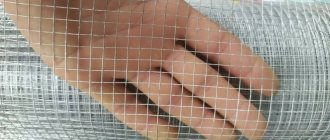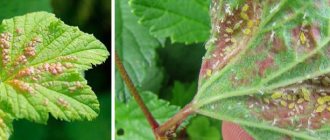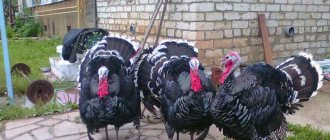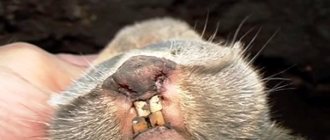In winter, a garden with fruit trees suffers not only from frost. Many gardeners are faced with such a nuisance as frequent rodent attacks. Furry animals feed on bark, thereby causing irreparable harm to the health of fruit trees. And given the fact that the plant is already having a hard time at this time of year, the result may be the death of the trees. The task of every gardener is to know how to protect apple trees from mice. A variety of methods can be used for this. In this article we will tell you how to best protect your orchard from mice.
Rodents are a real death for the winter garden
Why are rodents dangerous for apple trees?
It would seem, how can a small mouse damage a large tree, even a young one? In fact, this is a disaster for gardeners. First of all, the mouse never comes alone. A whole brood follows her. Just imagine if every mouse took at least a couple of bites. Secondly, mouse saliva contains a substance that not only stops the movement of sap through the tree, but also contributes to its decay. This means that even with small bite marks, you can begin to worry, because you risk becoming the owner of a rotten tree.
A small mouse can eat up to 50 g of bark per day
Thirdly, bites in the cold season. It turns out that the mouse provides access directly to the center of the tree trunk. If severe frosts strike, the apple tree will be susceptible to frostbite and simply die. Now imagine how much the probability of losing your orchard increases if not just one mouse, but a whole litter of mice gets into your habit? Appropriate measures must be taken urgently.
The mouse will not forget about the apple tree even if it is offered an alternative
Important! Even if you want to show mercy and feed the animals, leaving them special feeders, you will not protect your apple trees in this way. The mouse is designed in such a way that it eats everything that seems edible to it. Rodents will not stop if you overfeed them. They have no feeling of hunger or satiety. This means that along with the food offered to them, they will also damage fruit trees.
Collaboration with cats
It is difficult to overestimate the role of cats in regulating the mouse population in a garden plot. Two or three mousecatchers are able to cope with this problem no worse than creolin, and at the same time they can disperse all the moles.
MARIE Member of FORUMHOUSE
The best remedy is cats. I have a cat mother and her two sons, they all catch mice. I haven’t had any worries for four years now, I don’t have any mice or moles. And before that, whatever they did, they poured poison and installed an ultrasonic device.
Mariska Member of FORUMHOUSE
A permanently living cat in the barn + cats coming to visit her = no mice in the house and on the property.
Why do mice gnaw apple trees?
With the onset of cold weather, it’s not just plants that have a hard time. Hares, mice and other rodents are forced to look for food in the forests, where it becomes less and less every day. The attention of rodents is attracted by summer cottages where there is still something left to profit from. The bark of apple, pear and plum trees is rich in vitamins and minerals. In addition, it has a pleasant taste, which is so attractive to furry animals.
Winter is the hungriest time of the year
Also, under the bark there are insects that did not have time to hide from the winter frosts. They can also become bait. Therefore, even in the warm autumn, it is necessary to take appropriate measures to protect young trees, because they are the most attractive to mice.
Trampling and redistributing snow
In order for rodents to get close to such tasty plants - bulbs planted in flower beds and garden beds, bushes and trees - they must make their way through the snow and freely dig a hole or passage. The simplest measure available in winter - trampling down snow - creates a barrier for rodents that is sufficient for effective protection.
They trample down the snow, moving from the perimeter of the tree trunk circles to the trunk, in flower beds - between the plants, trying not to touch them.
A blanket of snow rarely covers the garden evenly, and snow periods are not stable. Effective redistribution of snow and additional snow cover of flower beds, ridges, protection of wintering shrubs and trees allows you to stabilize temperatures and use the best natural protection wisely, strengthening the barrier for rodents.
Snow is always distributed so that the most vulnerable plants are securely covered, and bare soil is protected from weathering and freezing. In addition, you need to add snow so that in the spring it effectively moistens the soil.
By finishing each snow distribution by compacting it near rodent-attracting plants, you reduce the risk of rodent problems.
Ways to protect apple trees from mice
Based on the experience of many gardeners, we can identify methods that will perfectly protect seedlings of apple trees, pears and other inhabitants of the garden. Choose the method that you consider most appropriate in the current situation.
Apple tree not protected from rodents
Sheltering fruit trees from rodents
If you are not a supporter of solutions and other mixtures, then you will like the covering method. It is needed to prevent rodents from damaging the trunk and bark of the tree with their sharp teeth. Most often, the following types are used as covering materials:
- bags;
- chain mail;
- spunbond;
- spruce branches;
- nylon tights;
- elastane;
Using plastic glasses
- plastic bottles;
- fiberglass;
- log bark.
- mulch;
- poisonous baits;
- whitewash;
- odorous mixtures.
You probably have one of these materials on hand.
Important! The tree trunk must be fenced with special material to a height of no more than one meter. The tree wrapped above does not receive the proper amount of oxygen.
The advantage of this method is that it is very simple and accessible to every gardener. The covering method is universal and protects well from attacks by furry animals. If you want to achieve better results and be sure that the garden is not attacked by animals, you can also use additional means of protection. These include:
Prices for fiberglass
fiberglass
Scare the mice
Mice and other rodents are quite shy animals. They are afraid of any rustle or extraneous sound. Knowing this feature, you can play on it. Buy several large black bags. Tie them to the trees with fishing line. In the wind, the packages will begin to develop and rustle. The sight of such scary, large and black “monsters” will frighten the animals, and they will only have to flee. If a rodent tries to eat tree bark on a windless day, you should think about additional methods of protection.
Fearfulness is the main trait of rodents
Mice fence
An excellent way to protect trees from encroachment is to install a chain-link fence. In addition to it, you can also use iron.
It is necessary to drive small poles around the tree to a height of 1 m, without damaging the root system.
Wrap a chain-link fence around the posts. Remember that the holes in it must be small enough so that the mouse cannot get through.
One of the best ways according to many gardeners
Secure the chain-link mesh with wire.
Do this with all the trees. This method of protection will work much better if the mesh is buried a few centimeters into the ground.
Important! Despite its miniature size, the mouse has amazing physical strength and endurance. Its paws are very tenacious and can climb very high, so it is possible that the rodent can climb over the chain-link mesh.
Prices for chain-link mesh
Rabitz
Protection with mixtures
A mouse has a very good sense of smell, so any smell that is not rodent-friendly will keep it away from your garden forever. Here it is important not to make a mistake with the mixture. We suggest considering several recipes that many gardeners consider effective. Recipe 1. You will need:
- fresh mullein;
- clay;
- water;
- 50 g creolin.
Making your own mixture is very easy.
All ingredients, except creolin, must be mixed in equal parts. The mixture is stirred until it becomes thick sour cream. Afterwards, you need to coat the tree trunk, as well as the self-erected fence.
Recipe 2. You will need:
- 5 g carp;
- 5 g creolin;
- 1 liter of water.
The ingredients are stirred until completely dissolved. Must be mixed with sawdust. After drying, the sawdust is laid out next to the trunk.
If you have coriander (popularly cilantro) growing on your property, this remedy will be your excellent helper. Mice are repelled by this smell. You can collect dried flowers and cilantro fruits and scatter them under the tree.
Coriander
And for the best effect, next year sow this plant directly under the apple trees. With one blow you will kill two birds with one stone: you will get a delicious seasoning for cooking and protect apple trees from mice.
Prices for creolin
creolin
Mouse bait
You can only leave bait on the property if you are sure that it will not get to your pets. This applies not only to your animals, but also to your neighbors, neighbors and homeless people. The most popular company for protecting orchards is Efa. The composition of this powder contains a lethal dose for rodents. The effect will be enough after just eating the bait once. What do you need:
- 10 g of powder should be poured into a plastic bag;
- place bags around tree trunks;
- if you know where the holes are located, you can leave the bait next to them;
- add bait as the quantity decreases from plastic bags.
As a rule, rodents begin to die within a day after taking the drug.
It is better to dilute the powder outside
You can make bait at home without purchasing expensive powders. To do this, you need to mix several teaspoons:
- flour;
- cement;
- alabaster;
- Sahara.
Proportions 1:1. Add half a teaspoon of sunflower oil to this mixture. Mix thoroughly. The bait should be updated once a week. They are laid out in the same way as with the above method.
Prices for the product "Efa"
Mouse f-hole
Ultrasound
If you spare no expense in preserving your orchard, ultrasonic protection is a suitable measure for you. Wave repelling is very effective, but according to many gardeners, it is not the most practical method in the winter. However, it can serve as a good measure of additional protection. Do not forget to constantly monitor the presence of batteries in the device or ensure a constant supply of electrical energy.
Additional method protection
When choosing an ultrasonic product, keep in mind that the emitted wavelengths should be sufficient to cover the entire perimeter of your area. It is important that the wave does not encounter any obstacles or barriers along its path. If your garden allows the installation of such a device, and, moreover, does not contain obstacles, then this method will be a good support in protecting fruit trees in winter.
Tree tying
Arm yourself with spruce branches. If you want to protect the plant even better, then wrap the tree trunk with spruce branches. The needles should point down. Instead of spruce spruce branches, roofing felt is also suitable. Iron mesh with small holes - chain mail - is also perfect. The material for tying must not only be distributed over the trunk, but also dug 10 cm into the soil. Otherwise, the mice will simply bypass it underground.
Mice cannot stand the smell of mint. Also, this smell is harmful to rats and other rodents. This plant emits a pungent odor, so rodents run from it like fire. You can hang bunches of mint on a tree trunk. It can be combined with wild rosemary or elderberry herbs.
Environmentally friendly material
If you decide in favor of using roofing felt, take care of removing it in March. Otherwise, if you forget to do this, the barrel will begin to rot, since such material does not allow air to pass through very well. There is a high risk that the young plant will simply rot.
The chainmail mesh will get very hot in the sun. These temperature fluctuations can cause the plant to die or lose its bark.
Important! Many gardeners use ordinary nylon tights. They are simply distributed along the trunk from the ground itself to the upper branches. Some mice stop when they see such an obstacle. However, some individuals still try to chew through the fabric. To play it safe, leave this method unused.
Lures
Laying out baits containing poisons is an effective method. For example, Efa is a well-known effective pesticide against mice and rats. Thanks to the properties of the latest generation active substance, rodents only need to eat the bait once or twice to receive a lethal dose. Pour 5–10 g (1–2 tsp) of Efa bait onto cardboard or polyethylene and place it both in rodent burrows and on the soil surface near tree trunks. Bait must be added as it is eaten. The death of rodents occurs a few days after eating the bait.
What can't you do?
Let's get acquainted with the list of actions that should not be done under any circumstances.
- Use straw as a covering or binding material. This is a real treat for furry ones.
- You should not use plastic bags as tying methods. They heat up in the cold and will lead to frostbite in the young tree. Some mice may try to chew through the plastic bag. This will lead to the death of the voles and, at the same time, damage to the trunk.
- You shouldn't indulge in poisons. This method will indeed help get rid of mice, but at the same time, will such a plant be safe for the next period? Indeed, in this matter you need to carefully calculate the proportions, have an idea of whether the apple tree belongs to a particular species, and so on. In order to protect yourself and your loved ones, it is better not to use this method.
Preventive measures
Proper care of the apple tree and preparation for winter will protect it from rodents. A well-maintained garden will not attract pests. Mice love to find secluded places under leaves and make passages in them. Therefore, in the fall, you need to carefully rake out all the leaves and remove piles of dry grass.
The areas around the trunks should be dug up, which will serve as an obstacle for rodents. Bare soil does not attract mice, as they prefer to make their way to tree trunks under the cover of dry grass. Digging should be done carefully so as not to cut the roots. Then you need to wrap the trunks of the apple trees.
Another preventive way to protect apple trees from mice in winter is to compact snow around the trunks. Such a barrier will not allow rodents to easily get to their treat, as they make their moves under a blanket of snow.
What to do if the bark is damaged?
If you did not manage to implement protective measures in time or for some reason the mice still managed to strike, you need to urgently begin protective actions. If you discover the damage early, the apple tree can still be saved.
Table 1. Recipes for protection against rodents.
| Damage level | Method of protection |
| Minor |
|
| Average |
|
| Strong |
|
| Very much | If it is discovered that the tree has been damaged by mice in the spring, some varieties of fruit trees can still be revived. To do this, you need to use “bridge grafting.”
|
| Cannot be resuscitated | If damage to the tree trunk indicates that salvage is not possible, you will need to cut down the trunk. It is necessary to make the cut a couple of centimeters higher from the lower bud. With proper protection, new shoots will develop on the stump, which will give good growth. The cut should be washed with garden varnish once a week. This procedure needs to be done once every 5 years, even if the tree is healthy. |
Protecting and preserving damaged trees from mice is a very controversial and problematic issue. Neither one nor the other method of protection and recovery is a panacea; it works for some, but not for others.
Complex manipulation of bridge grafting
Therefore, in order not to encounter unpleasant consequences in the form of tree death, you need to carefully consider the issue of protection even before the onset of cold weather. Experiment and find new and improved methods year after year. In the end, through trial and error, you will find the very method that will protect your beloved garden, and the apple trees will become real pride and the personification of your work.
Repellents
By their nature, hares are very timid animals, so ordinary large black plastic bags will be a good way to scare them away. They need to be hung next to trees or on lower branches. Creating a rustle with every gust of wind, the bags will serve as an appropriate imitation of a scarecrow in the fight against uninvited rodents.
You can hang black cardboard circles with a diameter of about 150 mm (2-3 pieces per tree) on the lower branches of trees. They are very different against the background of snow and when the wind moves, they scare away with their movement.
You can cut ribbons from soda cans and twist them into a spiral. Then hang them on the lower branches of trees so that when the wind blows they hit each other.
An alternative option is bright woven ribbons (preferably red). You can hang plastic bottles with holes on the lower branches with naphthalene tablets in them. Its pungent smell will repel rodents. During the winter period, it is advisable to renew the tablets several times.
Which trees are at risk?
Hares and field mice, which most often attack gardens, have their own taste preferences, which is why some trees stand untouched, while others die from damage. For example, rodents attack pears only when there is absolutely nothing to eat, but apple trees, especially young ones, are in trouble.
The following trees are not attacked at all:
- apricots;
- cherry plum;
- plum;
- cherry;
- peaches.
The explanation here is simple: the bark of stone fruit species is very bitter, and it is impossible to eat it. However, there may be some minor damage from animals on these trees, but it is not life-threatening. It turns out that the closest attention should be paid to the protection of young apple trees.











